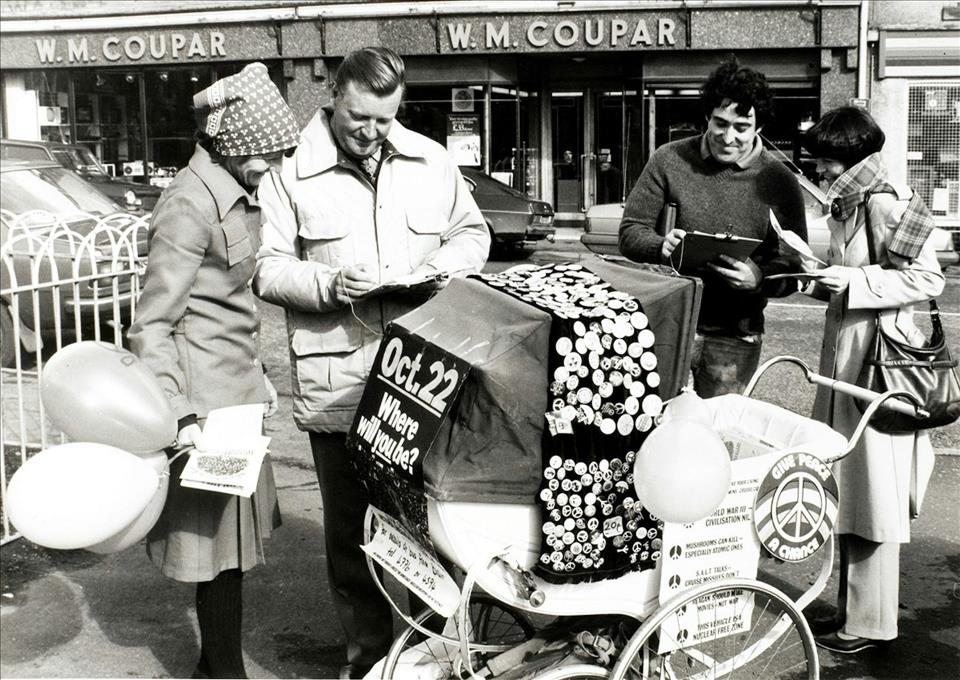
Cold War Scotland Show Reveals Impact Of Conflict On Scottish Politics, Culture And Memory
Our sense of fun, sadly, only lasted until shortly after the opening credits. The film, initially banned by the BBC, left us open-mouthed and terrified as we trooped back home staring intently at the wrecked flower beds we had destroyed earlier.
The following evening, we were reprimanded for attending the school Halloween disco dressed as casualties of a Russian nuclear attack.
Today, we are known as generation X – children of the cold war. We are apparently renowned for being disaffected and directionless. Some even refer to us as“the bleak ones”, constantly in fear of annihilation. The war in Ukraine hasn't helped. Fuelling our mid-life nightmares of mushroom-shaped nuclear explosions in the fields behind our suburban homes. And rekindling memories of makeshift nuclear shelters we tried to dig with our bare hands as kids in the 1970s.
It is against this backdrop that Cold War Scotland explores the stories of Scots at the centre of this global conflict. The National Museum of Scotland exhibition showcases how the impact of that war still lingers in Scottish politics, culture and memory.
The exhibition starts with a series of short films depicting how Scotland became a cold war battleground. The geographic position of Scotland between the US and the USSR, and direct access to the Atlantic meant Scotland would play a vital role for the North Atlantic Treaty Organisation's (Nato) defences. Faslane, on the banks of Gare Loch, is the site of the UK's only nuclear submarine base. The show demonstrates how nuclear power and nuclear weapons came to dominate peoples' minds – and how Scottish communities were explicitly told they were nuclear targets.
Cold war on displayThe CND map on display in the Cold War Scotland exhibition. National Museums Scotland
There are dozens of objects on display to“trigger” the sensitive gen Xer's consciousness, including secret intelligence documents and a map of central Scotland marked to highlight targets under threat of nuclear attack.
The giant twin steel-making boilers of Ravenscraig in Motherwell were always visible from my bedroom in Hamilton. Our neighbour worked there.“That's the first place The Russians will hit around here son,” he told me, muscly iron ore arms folded. He was right. It is on the map. As is Faslane , close to where I currently live.
The exhibition shows how Scots played an active role in the global conflict as soldiers, within intelligence services and as part of voluntary civil defences. The argument in the playground was often about whose dad worked where, and why the nuclear industry provided jobs and security.
Yet not everyone bought into that particular dream. First-hand accounts include a young mother who decorated her daughter's pram with Campaign for Nuclear Disarmament (CND) badges. A rattle made from an old laundry detergent bottle emblazoned with the CND logo was given to them during the peace marches of the early 1980s and is on display.
As Meredith Greiling, principal curator of technology at National Museums Scotland, explains :“From nuclear submarines to lively peace protests and observation stations perpetually monitoring for devastating attack, the cold war permeated every aspect of life in Scotland for decades.” This is true.
Curator Meredith Greiling puts the finishing touches to Cold War Scotland. National Museums Scotland
She also claims that the exhibition aims to“offer a Scottish perspective of the period, allowing Scots from all walks of life to tell their remarkable stories for the first time.” But the sometimes robotic emphasis on the scientific, historic and social delivery of the films in the exhibition stops short of demonstrating how the cold war still dominates peoples' minds.
It is time for children of the 1970s like me to reflect on our adolescent nuclear nightmares and demonstrate that our intellectual consciousness stretches beyond the nuclear mushrooms of our childhood machinations. In that sense this eye-opener of an exhibition could stage a sequel, perhaps documenting how current conflicts such as the war in Ukraine coalesce with our historic experiences of heightened nuclear threat.
That way we can at least explain to our children why our dusty old“build your own DIY nuclear bunker” manuals can and should be consigned to the darkest cellars of our minds forever. In their place a new, more nuanced narrative will emerge; one free from both the crude and subtle forms of propaganda we witnessed then and now.
Looking for something good? Cut through the noise with a carefully curated selection of the latest releases, live events and exhibitions, straight to your inbox every fortnight, on Fridays. Sign up here .
- History
- Scotland
- Cold War
- Exhibition
- Give me perspective

Legal Disclaimer:
MENAFN provides the information “as is” without warranty of any kind. We do not accept any responsibility or liability for the accuracy, content, images, videos, licenses, completeness, legality, or reliability of the information contained in this article. If you have any complaints or copyright issues related to this article, kindly contact the provider above.


















Comments
No comment